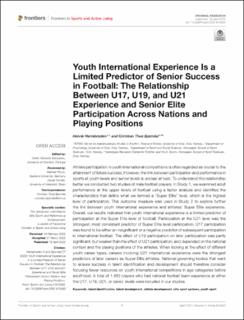| dc.contributor.author | Herrebrøden, Henrik | |
| dc.contributor.author | Bjørndal, Christian Thue | |
| dc.date.accessioned | 2022-07-04T10:56:13Z | |
| dc.date.available | 2022-07-04T10:56:13Z | |
| dc.date.created | 2022-05-13T13:24:32Z | |
| dc.date.issued | 2022 | |
| dc.identifier.citation | Frontiers in Sports and Active Living. 2022, 4, Artikkel 875530. | en_US |
| dc.identifier.issn | 2624-9367 | |
| dc.identifier.uri | https://hdl.handle.net/11250/3002565 | |
| dc.description | This is an open-access article distributed under the terms of the Creative Commons Attribution License (CC BY). The use, distribution or reproduction in other forums is permitted, provided the original author(s) and the copyright owner(s) are credited and that the original publication in this journal is cited, in accordance with accepted academic practice. No use, distribution or reproduction is permitted which does not comply with these terms. | en_US |
| dc.description.abstract | Athlete participation in youth international competitions is often regarded as crucial to the attainment of future success. However, the link between participation and performance in sports at youth levels and senior levels is unclear at best. To understand this relationship better we conducted two studies of male football players. In Study 1, we examined adult performance at the upper levels of football using a factor analysis and identified the characteristics that define what we termed a “Super Elite” level, which is the highest level of participation. This outcome measure was used in Study 2 to explore further the link between youth international experience and athletes' Super Elite experience. Overall, our results indicated that youth international experience is a limited predictor of participation at the Super Elite level of football. Participation at the U21 level was the strongest, most consistent predictor of Super Elite level participation. U17 participation was found to be either an insignificant or a negative predictor of subsequent participation in international football. The effect of U19 participation on later participation was partly significant, but weaker than the effect of U21 participation, and depended on the national context and the playing positions of the athletes. When looking at the effect of different youth career types, careers involving U21 international experience were the strongest predictors of later careers as Super Elite athletes. National governing bodies that want to ensure success in talent identification and development should therefore consider focusing fewer resources on youth international competitions in age categories before adulthood. A total of 1,482 players who had national football team experience at either the U17, U19, U21, or senior levels were included in our studies. | en_US |
| dc.language.iso | eng | en_US |
| dc.subject | athlete development | en_US |
| dc.subject | elite sport systems | en_US |
| dc.subject | talent development | en_US |
| dc.subject | talent identification | en_US |
| dc.subject | youth sport | en_US |
| dc.title | Youth international experience is a limited predictor of senior success in football: The relationship between U17, U19, and U21 experience and senior elite participation across nations and playing positions | en_US |
| dc.type | Peer reviewed | en_US |
| dc.type | Journal article | en_US |
| dc.description.version | publishedVersion | en_US |
| dc.rights.holder | © 2022 Herrebrøden and Bjørndal | en_US |
| dc.source.pagenumber | 11 | en_US |
| dc.source.volume | 4 | en_US |
| dc.source.journal | Frontiers in Sports and Active Living | en_US |
| dc.identifier.doi | 10.3389/fspor.2022.875530 | |
| dc.identifier.cristin | 2024383 | |
| dc.description.localcode | Institutt for idrett og samfunnsvitenskap / Department of Sport and Social Sciences | en_US |
| dc.source.articlenumber | 875530 | en_US |
| cristin.ispublished | true | |
| cristin.fulltext | original | |
| cristin.qualitycode | 1 | |
